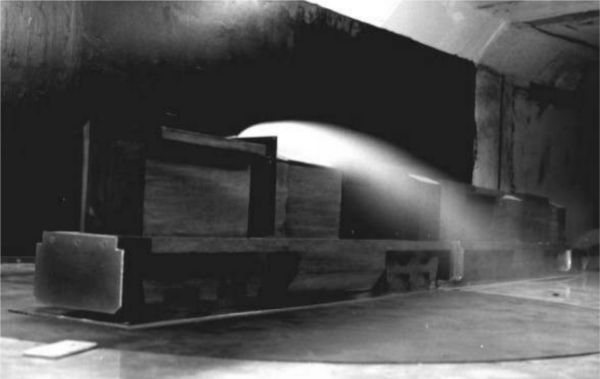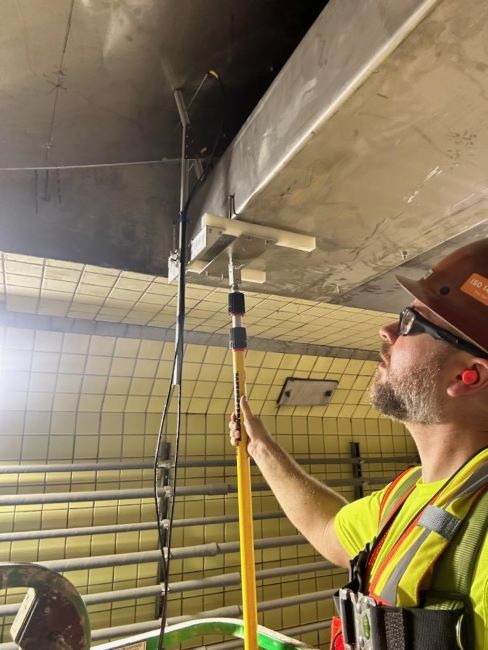Vehicle Exhaust Plume Tracking
By Wendy Beale and Kevin Linfield, Ph.D., P.Eng., P.E.
In a previous blog, we discussed the requirements of the US Department of Veteran Affairs Office of Construction and Facilities Management for using CFD modeling or wind tunnel analysis to ensure that odors and hazardous exhausts are not entering into VA medical facilities. But buildings are not the only places where dispersion modeling and field testing is needed.
Combustion engines produce exhaust that account for a significant amount of pollution in the form of carbon dioxide, carbon monoxide, nitrogen oxides, and hydrocarbons. The cars, trucks, trains, boats, and airplanes that we use on a daily basis can all create poisonous exhaust that is dangerous for the occupants and those around the vehicles. Dispersion analysis of exhaust is important and can be performed using both computer and laboratory flow modeling techniques. Certain areas of our roadways, like tunnels, benefit from field testing the ventilation systems to ensure drivers remain safe on their travels.
CFD Modeling

Locomotive plume dispersion with wind at 50 mph.
CFD modeling utilizes sophisticated software, like AzoreCFD®, to predict flow patterns and gas mixing. This data can then be used to study exhaust plume behavior. That behavior can vary depending on wind conditions, whether the vehicle is moving or at idle, and proximity to nearby buildings. It also helps predict:
- flammability limits
- pollutant transport/concentration
- thermal mapping
- toxic fume levels
The results of CFD modeling can then be used to help quantify exhaust flow patterns and concentrations of gas components in the vicinity of the vehicle. This information can be used to make changes to the vehicle's exhaust systems.
In this video, ASC engineers, using AzoreCFD®, modeled a yacht's exhaust plume at varying wind speeds to track the dispersion of toxic exhaust. You can see how exhaust can blanket the upper deck and be harmful to passengers.

The anchored yacht shown above was modeled to predict the diesel exhaust concentration at various locations both in and around the vessel.
Physical/Laboratory Modeling
ASC also uses laboratory testing by employing scale models to confirm flow paths and plume dispersion. Large fans direct flow over scale models, while smoke injection and other techniques are used to visualize and assess gas plume concentrations. In the Airflow Sciences' lab, our technicians perform all aspects of model testing including design and construction, probe calibration, wind tunnel testing, data reduction, and result documentation.

1:15 scale wind tunnel locomotive with smoke injection.
Field Testing
Sometimes, it isn't the vehicle that needs to be examined, but the actual roadway. ASC is called in to test the way plumes are dissipated from enclosed motorways, like highway tunnels.
The ventilation systems within tunnels are tasked with removing exhaust continuously to reduce the build up of emissions. During a high risk event such as a car fire, these fans and ventilation systems are needed to maintain the safety of those who may be trapped in the tunnel. We assess flow rates and static pressure rise generated by the fans at various operational settings to ensure safe driving conditions during regular inspections of these tunnels as specified by the requirements set forth by The Federal Highway Administration. Learn more about Air Flow Testing for Highway Tunnels through a short video, featuring Kevin Linfield Ph.D., P.Eng., P.E.

ASC testing crew conducting performance testing on a new fan installed for ventilation in a traffic tunnel.
As a flow testing service provider, we offer state-of-the-art equipment accompanied by the highest level of industry experience, providing tunnel owners and transportation departments with the accurate flow data that they need to keep their roadway assets protected and maintained.
Airflow Sciences Corporation (ASC) is a fluid dynamics solutions company, specializing in the design and optimization of equipment and processes involving flow, heat transfer, combustion, and mass transfer. Now celebrating 50 years as an industry leader, ASC has focused on testing and simulation of air, gas, liquid, and particulate flows since 1975.
ASC also manufactures standard and custom test equipment, including probes and wind tunnels, enabling customers to collect data accurately and efficiently. ASC's primary CFD software, AzoreCFD®, is also available for customers with in-house CFD personnel. ASC offers comprehensive flow solutions and optimization and serves a wide range of industries including HVAC, power, auto, rail, and food processing.
